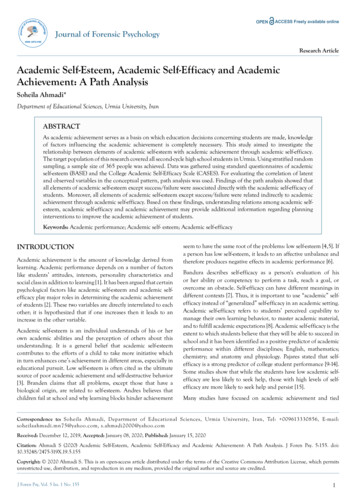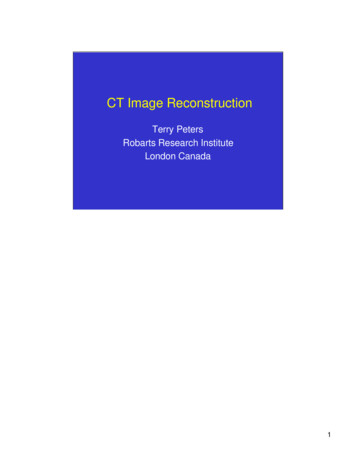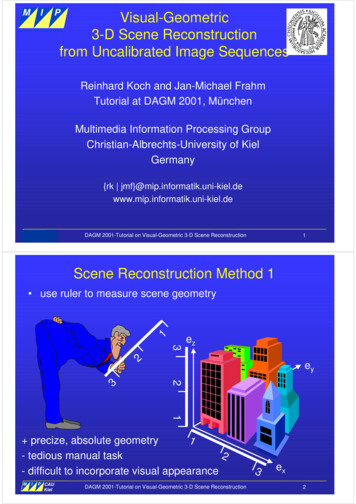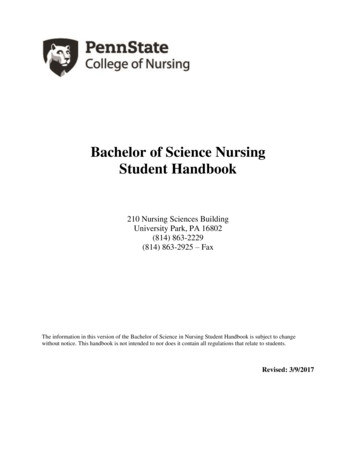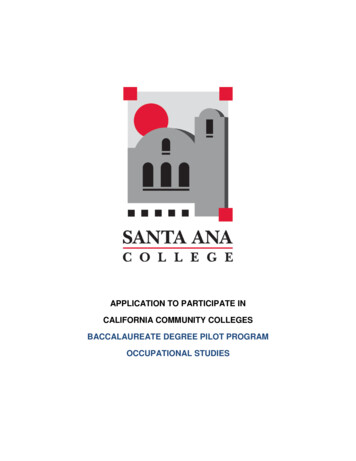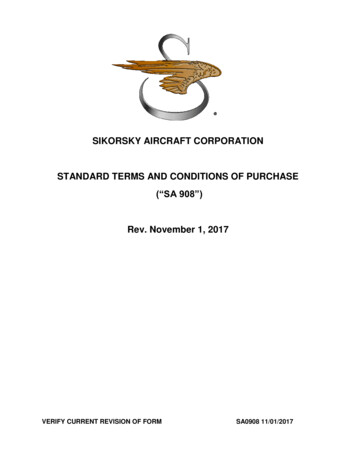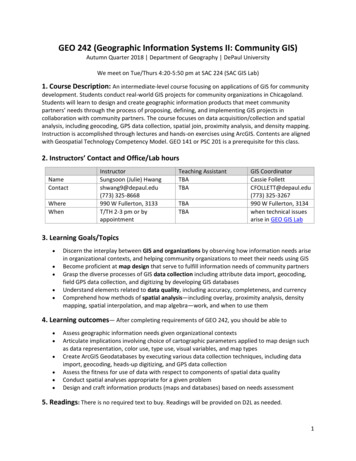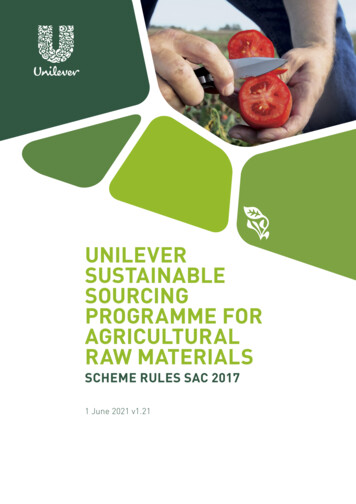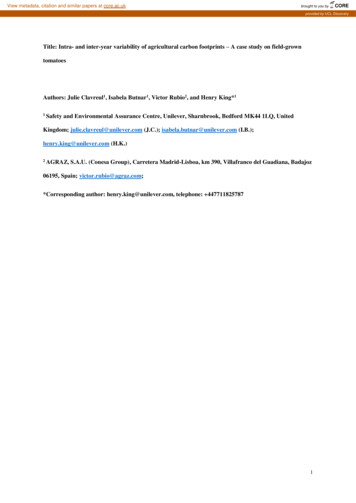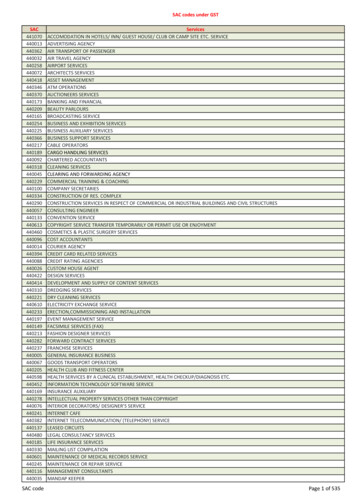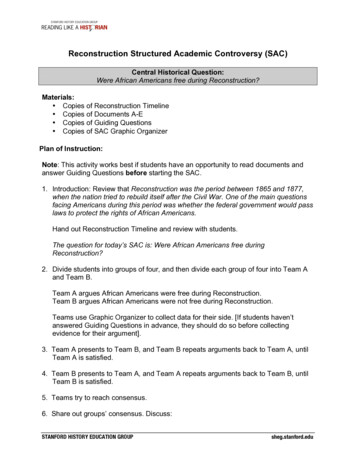
Transcription
Reconstruction Structured Academic Controversy (SAC)Central Historical Question:Were African Americans free during Reconstruction?Materials: Copies of Reconstruction Timeline Copies of Documents A-E Copies of Guiding Questions Copies of SAC Graphic OrganizerPlan of Instruction:Note: This activity works best if students have an opportunity to read documents andanswer Guiding Questions before starting the SAC.1. Introduction: Review that Reconstruction was the period between 1865 and 1877,when the nation tried to rebuild itself after the Civil War. One of the main questionsfacing Americans during this period was whether the federal government would passlaws to protect the rights of African Americans.Hand out Reconstruction Timeline and review with students.The question for today’s SAC is: Were African Americans free duringReconstruction?2. Divide students into groups of four, and then divide each group of four into Team Aand Team B.Team A argues African Americans were free during Reconstruction.Team B argues African Americans were not free during Reconstruction.Teams use Graphic Organizer to collect data for their side. [If students haven’tanswered Guiding Questions in advance, they should do so before collectingevidence for their argument].3. Team A presents to Team B, and Team B repeats arguments back to Team A, untilTeam A is satisfied.4. Team B presents to Team A, and Team A repeats arguments back to Team B, untilTeam B is satisfied.5. Teams try to reach consensus.6. Share out groups’ consensus. Discuss:STANFORD HISTORY EDUCATION GROUPsheg.stanford.edu
Were African Americans free during Reconstruction? In what ways?What does it mean to be free? Based on these documents, was Reconstruction a success or failure? CitationsDocument AU.S. Constitution, Amendments 13-15. Retrieved fromhttp://www.senate.gov/civics/constitution item/constitution.htm#amendments.Document BOpelousas, Louisiana, black code, July 3, 1865. In Senate executive documents for the firstsession of the thirty-ninth Congress of the United States of America, 1865-1866 (pp. 92-93).Washington, DC: Government Printing Office. Retrieved unitDocument CSenate Report 693, 46th Congress, 2nd Session (1880). Reprinted in Dorothy Sterling, editor,The Trouble They Seen: The Story of Reconstruction in the Words of African Americans, NewYork: Da Capo Press, 1994. Retrieved arecrop/ps adams.htmlDocument DPortraits retrieved from the Library of Congress website, http://www.loc.gov/index.html.Document ESidney Andrews quoted in the Joint Report on Reconstruction, (1866) pp. 174. Retrieved congrichAcknowledgmentsWe thank Professor Walter Parker at the University of Washington's College of Education for helping us see theenduring value of the SAC approach in the history classroom.STANFORD HISTORY EDUCATION GROUPsheg.stanford.edu
Reconstruction Timeline1865The Civil War ends.Republican President Abraham Lincoln is assassinated.Democrat Andrew Johnson becomes president.13th Amendment to the Constitution passes.Congress creates the Freedmen’s Bureau to help freedmen and women transition from slavery.1866Civil Rights Act of 1866 allows African Americans to ownproperty and to be treated equally in court.The Ku Klux Klan is founded.1867Radical Republicans take over the United Statesgovernment.186814th Amendment to the Constitution passes.First African American elected to United States Congress.1869Ulysses S. Grant is elected president.187015th Amendment to the Constitution passes.1871Congress passes the Ku Klux Klan Act of 1871 inresponse to reports of widespread violence in the South.1872The Freedmen’s Bureau ends.1874Democrats take control of the United States Congress.Radical Republicans are no longer in power.1877Rutherford B. Hayes is elected President and officiallyends Reconstruction. Hayes pulls all remaining Northerntroops out of the Southern states.STANFORD HISTORY EDUCATION GROUPsheg.stanford.edu
Document A: The Reconstruction Amendments (Modified)The 13th, 14th and 15th amendments to the United States Constitution aresometimes called the “Reconstruction Amendments.” They were passed inorder to abolish slavery and to establish the rights of former slaves.13th Amendment: 1865Section 1. Neither slavery nor involuntary servitude, except as apunishment for crime whereof the party shall have been duly convicted,shall exist within the United States, or any place subject to theirjurisdiction.14th Amendment: 1868Section 1. All persons born or naturalized in the United States . . . arecitizens of the United States and of the State wherein they reside. No Stateshall make or enforce any law which shall abridge the privileges orimmunities of citizens of the United States; nor shall any State deprive anyperson of life, liberty, or property, without due process of law; nor deny toany person within its jurisdiction the equal protection of the laws.15th Amendment: 1870Section 1. The right of citizens of the United States to vote shall not bedenied or abridged by the United States or by any State on account of race,color, or previous condition of servitude.Vocabularyjurisdiction: legal controlnaturalized: made citizensabridge: limitimmunities: rightsSTANFORD HISTORY EDUCATION GROUPsheg.stanford.edu
Document B: Black Codes (Modified)In the years following the Civil War, many Southern states and citiespassed Black Codes. These laws laid out what freed blacks were and werenot allowed to do. The document below, passed July 3, 1865, is a BlackCode from Opelousas, Louisiana.SECTION 1. No negro shall be allowed to come within the limits ofthe town of Opelousas without special permission from his employers.SECTION 3. No negro shall be permitted to rent or keep a housewithin the limits of the town under any circumstances.SECTION 4. No negro shall reside within the limits of the town ofOpelousas who is not in the regular service of some white person or formerowner.SECTION 5. No public meetings of negroes shall be allowed withinthe limits of the town of Opelousas under any circumstances without thepermission of the mayor or president of the board of police. This, however,does not prevent the freedmen from attending the usual church services.SECTION 7. No freedman who is not in the military service shall beallowed to carry firearms, or any kind of weapons, within the limits of thetown of Opelousas without the special permission of his employer, inwriting, and approved by the mayor or president of the board of police.SECTION 11. All the foregoing provisions apply to freedmen andfreedwomen.Source: Black Code from Opelousas, Louisiana, July 3, 1865.Vocabularyreside: to live inSTANFORD HISTORY EDUCATION GROUPsheg.stanford.edu
Document C: Henry Adams Statement (Modified)In September 1865 I asked the boss to let me go to the city of Shreveport.He said, "All right, when will you come back?" I told him "next week." Hesaid, "You had better carry a pass." I said, "I will see whether I am free bygoing without a pass."I met four white men about six miles south of town. One of them asked mewho I belonged to. I told him no one. So him and two others struck me witha stick and told me they were going to kill me and every other Negro whotold them that they did not belong to anyone. They left me and I then wenton to Shreveport. I saw over twelve colored men and women, beat, shot andhung between there and Shreveport.Sunday I went back home. The boss was not at home. I asked the madam[the boss’s wife], "where was the boss?" She said, "You should say 'master'.You all are not free . . . and you shall call every white lady 'missus' andevery white man 'master.'"During the same week the madam took a stick and beat one of the youngcolored girls, who was about fifteen years of age. The boss came the nextday and whipped the same girl nearly to death. . . . After the whipping alarge number of young colored people decided to leave that place forShreveport. [On our way], out came about forty armed white men and shotat us and took my horse. They said they were going to kill every coloredperson they found leaving their masters.Source: Former slave Henry Adams made this statement before the U.S.Senate in 1880 about the early days of his freedom after the Civil War.STANFORD HISTORY EDUCATION GROUPsheg.stanford.edu
Document D: Elected Black Officials during ReconstructionDuring Reconstruction, thousands of African Americans were elected to localand state governments throughout the Southern states. In addition, 17 AfricanAmericans were elected to the United States Congress from Southern statesbetween 1870 and 1877. Here are photographs of 6 of these 17 electedofficials.STANFORD HISTORY EDUCATION GROUPsheg.stanford.edu
Document E: Education (Modified)In 1865 the United States government created the Freedmen’s Bureau tohelp former slaves in Southern states. The Freedmen’s Bureau helpedpeople by providing medical supplies and health care and establishingschools.The creation of schools for former slaves was an important part ofReconstruction. Before the Civil War, Southern states outlawed theteaching of reading and writing to slaves.Many of the negroes . . . common plantation negroes, and day laborers inthe towns and villages, were supporting little schools themselves.Everywhere I found them hoping to get their children into schools. I oftennoticed that workers in stores and men working in warehouses, and cartdrivers on the streets, had spelling books with them, and were studyingthem during the time they were not working. Go outside any large town inthe South, and walk among the negro housing, and you will see childrenand in many cases grown negroes, sitting in the sun alongside their cabinsstudying.Source: Sidney Andrews quoted in the Joint Report on Reconstruction,1866. The document above is an excerpt from a report by a Northern whiteman to the United States government in 1866.STANFORD HISTORY EDUCATION GROUPsheg.stanford.edu
NameGuiding QuestionsDocument A: The Reconstruction Amendments1. When were the 13th, 14th and 15th amendments passed?2. Why do you think they were passed?3. What rights did they guarantee for American citizens?Document B: Black Codes1. When were these Black Codes written? Who do you think wrote these laws?2. List three things that freed men and women were not allowed to do according to theBlack Codes.3. Why would white Southerners pass laws that controlled the movement of AfricanAmericans? What would happen if African Americans left the South in hugenumbers?4. How do these laws help you to understand what life was like in Louisiana and otherSouthern states after the Civil War?STANFORD HISTORY EDUCATION GROUPsheg.stanford.edu
Document C: Henry Adams’s Statement1. Who wrote this document? When and why was it written?2. According to Adams, what was life like for freed men and women after the Civil War?3. Do you trust the account in this document? Why or why not?Document D: African American Political RepresentationWhat does this information about African-American politicians tell you about what life waslike for African Americans during Reconstruction?Document E: Education1. Why do you think education was important to former slaves during Reconstruction?2. How does this description of life for freedmen compare to Henry Adams’s statement?STANFORD HISTORY EDUCATION GROUPsheg.stanford.edu
Structured Academic Controversy:ReconstructionReconstruction was the period between 1865 and 1877, when the nation tried to builditself after the Civil War.During today’s class, you will work in teams to discuss whether or not AfricanAmericans were free during Reconstruction. Your goals for today should include lookingat all the issues, seeing both sides, and finding common ground.SAC QUESTION: Were African Americans free duringReconstruction?Team A will argue: YES, African Americans were free during Reconstruction.Team B will argue: NO, African Americans were NOT free duringReconstruction.PROCEDURE30 minutes With your teammate, read the documents in the Reconstructiondocument set. Find four pieces of evidence which support your side10 minutes Team A presents. BOTH PARTNERS MUST PRESENT!!!Team B writes down Team A’s arguments and then repeats themback to Team A.10 minutes Team B presents. BOTH PARTNERS MUST PRESENT!!!Team A down arguments of Team B and then repeats them back toTeam B.10 minutes Everyone CAN ABANDON their positions. Group of 4 attempts to developa consensus.STANFORD HISTORY EDUCATION GROUPsheg.stanford.edu
NameORGANIZING THE EVIDENCEUse this space to write your main points and the main points made by the other side.African Americans WERE free during Reconstruction: List the 4 mainpoints/evidence that support this side.1) From Document :2) From Document :3) From Document :4) From Document :African Americans were NOT free during Reconstruction: List the 4 mainpoints/evidence that support this side.1) From Document :2) From Document :3) From Document :4) From Document :STANFORD HISTORY EDUCATION GROUPsheg.stanford.edu
Coming to ConsensusSTARTING NOW, YOU MAY ABANDON YOUR ASSIGNED POSITION AND ARGUEFOR EITHER SIDE.Use the space below to outline your group’s agreement. Your agreement shouldaddress evidence and arguments from both sides.STANFORD HISTORY EDUCATION GROUPsheg.stanford.edu
laws to protect the rights of African Americans. . was Reconstruction a success or failure? Citations Document A U.S. Constitution, Amendments 13-15. Retrieved from . and state governments throughout the Southern states. In addition, 17 African Americans were e

